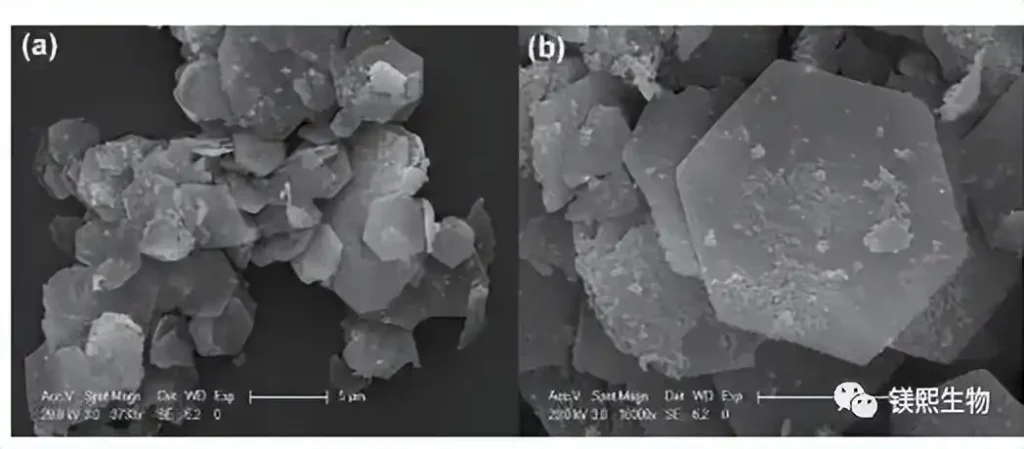Messi Biology states that hexagonal platelet magnesium hydroxide (Mg(OH)₂) is an inorganic, environmentally friendly flame retardant. Due to its high thermal stability, smoke suppression capabilities, and halogen-free, eco-friendly characteristics, it is widely used in the flame-retardant systems of polymeric materials such as rubber and plastics. Its hexagonal platelet morphology demonstrates significant advantages in improving flame-retardant performance and enhancing the mechanical properties of composite materials.

1. Basic Flame-Retardant Principle
Hexagonal platelet magnesium hydroxide is a typical physical-type inorganic flame retardant. Its primary flame-retardant mechanisms include: ① endothermic decomposition at high temperatures, which lowers the material’s surface temperature; ② the release of water vapor during decomposition, which dilutes flammable gases; and ③ the formation of a dense protective layer of magnesium oxide on the material’s surface, which insulates against heat and oxygen. These processes work together to inhibit combustion and smoke release.
2. Structural Advantages of the Hexagonal Platelet Morphology
Compared to traditional granular Mg(OH)₂, the hexagonal platelet morphology has a larger specific surface area and a two-dimensional structure. This allows it to be better distributed within the polymer material, forming an effective barrier layer. This “lamellar barrier” effect can prolong the diffusion path of heat and decomposition gases, thereby increasing flame-retardant efficiency.
3. Flame-Retardant Effect on Rubber
In elastomers such as natural rubber and styrene-butadiene rubber, hexagonal platelet magnesium hydroxide, as an additive flame retardant, can significantly inhibit flame spread, increase the oxygen index, and reduce the heat release rate. At the same time, it can also improve the dimensional stability of rubber at high temperatures, helping to extend the fire resistance time of rubber products.
4. Flame-Retardant Effect on Plastics
Adding hexagonal platelet Mg(OH)₂ to thermoplastics such as polyethylene (PE), polypropylene (PP), and ethylene-vinyl acetate copolymer (EVA) can effectively upgrade their flame-retardant rating, for instance, to UL-94 V-0 level, while offering the advantages of low smoke and non-toxicity. Due to its relatively high decomposition temperature, it is suitable for various thermoplastic processing techniques.
5. Synergistic Effects to Enhance Flame Retardancy
Hexagonal platelet Mg(OH)₂ can be used synergistically with phosphorus-based flame retardants, intumescent flame retardants, and silicones. Through a dual-action mechanism in both the condensed and gas phases, it improves the density and thermal insulation of the char layer, thus significantly enhancing the overall flame-retardant effect.
6. Surface Modification to Improve Compatibility
Surface modification of hexagonal platelet Mg(OH)₂ with coupling agents (such as silanes or stearic acid) can significantly improve its dispersion and interfacial adhesion within the polymer matrix. This reduces agglomeration and enhances the material’s mechanical properties, avoiding the issue of “poor performance despite high addition levels.”
7. Synergistic Optimization of Mechanical Properties
Thanks to the physical reinforcing effect of the platelet structure, the appropriate addition of hexagonal platelet Mg(OH)₂ not only avoids weakening the toughness and tensile strength of rubber and plastic materials but can actually improve mechanical properties such as tear strength and hardness. This makes it particularly suitable for engineering plastics that require both flame retardancy and structural strength.
8. Good Processing Adaptability
Hexagonal platelet Mg(OH)₂ performs well in conventional processing methods like extrusion, injection molding, and compression molding. It exhibits high thermal stability, is not easily decomposed, and does not release harmful substances, making it suitable for producing flame-retardant products such as wire and cable sheathing, flooring, home appliance casings, and automotive interiors.
